Seven beautiful wildflowers can transform your handcrafted soaps into natural works of art. You'll discover golden hues from calendula, gentle lavender tones from purple mallow, romantic pinks from wild roses, and striking blues from cornflowers. Safflower offers a vibrant spectrum from yellow to crimson, while hibiscus creates deep ruby shades, and chamomile adds subtle yellow undertones. Each flower brings unique therapeutic benefits and skin-nourishing properties to enhance your soap-making journey.
Calendula Petals: Nature's Golden Dye
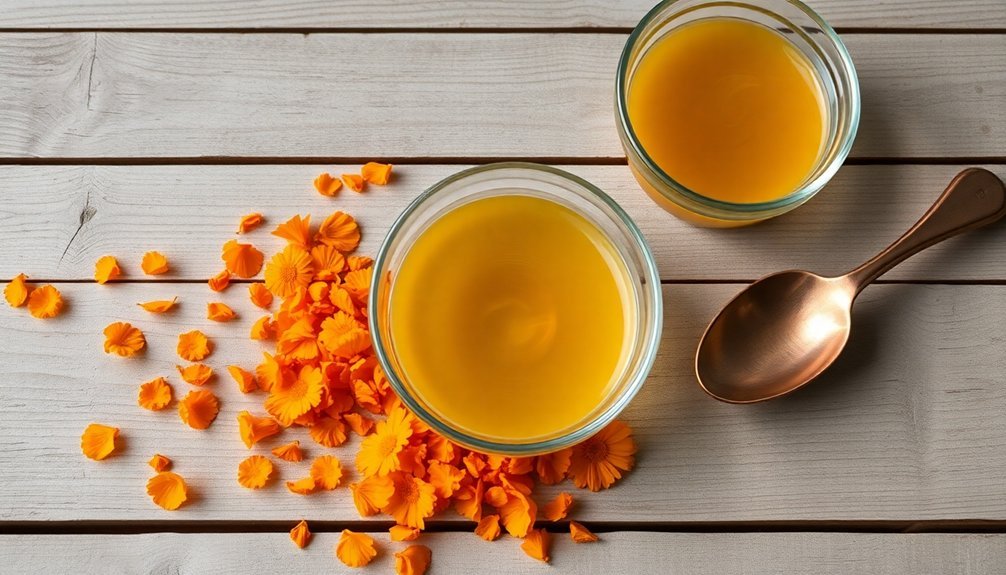
A burst of sunshine in your soap-making journey awaits with calendula petals. You'll discover these vibrant golden flowers offer more than just visual appeal when crafting your handcrafted soaps.
As a natural dye, calendula's water-soluble pigments blend seamlessly into your soap base without compromising texture.
When you're selecting your ingredients, opt for organically grown calendula to guarantee your soaps remain free from harmful chemicals. You'll benefit from the flower's rich antioxidants and skin-soothing qualities, making your creations both beautiful and beneficial for sensitive skin.
Keep in mind that your soap's final color will vary depending on pH levels and the amount of petals you use. By incorporating these golden blooms, you're not just adding color – you're infusing your soaps with nature's therapeutic properties.
Purple Mallow Blossoms for Lavender Hues
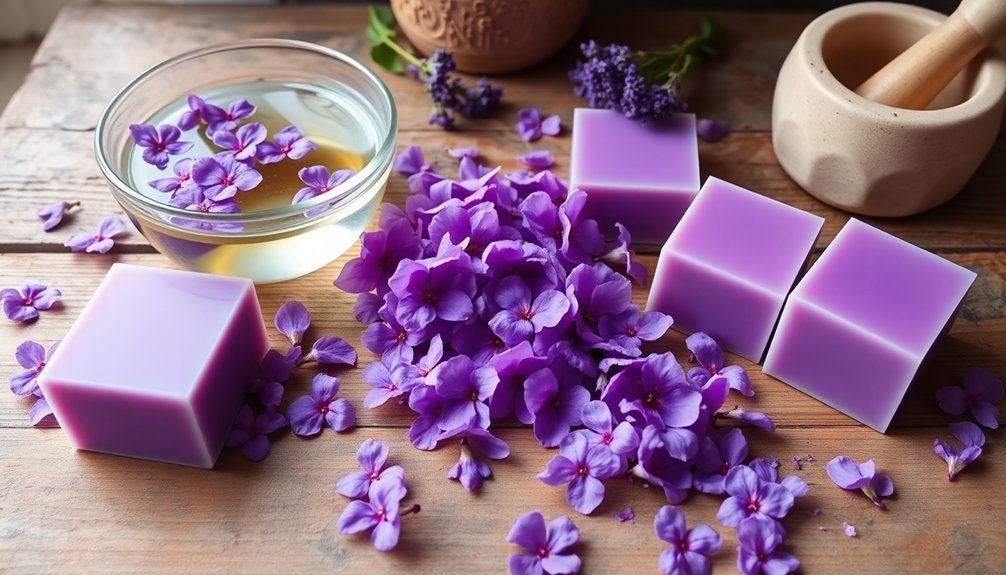
Moving from golden tones to cooler shades, purple mallow blossoms offer soap makers a natural way to achieve beautiful lavender hues in their creations.
You'll find these natural pigments are perfect for handcrafted soaps, providing a safe and eco-friendly coloring option that'll make your products stand out.
When you're formulating your soaps, you can adjust the concentration of purple mallow to achieve your desired lavender hue.
These blossoms work particularly well with floral scents, especially rose geranium, creating a visually appealing and aromatic combination.
You'll appreciate that purple mallow doesn't just add color – it also brings skin-nourishing qualities through its antioxidant properties.
Whether you're crafting simple bars or luxurious botanical soaps, these natural pigments will help you create stunning products that align with eco-conscious values.
Wild Rose Pigments and Their Pink Palette
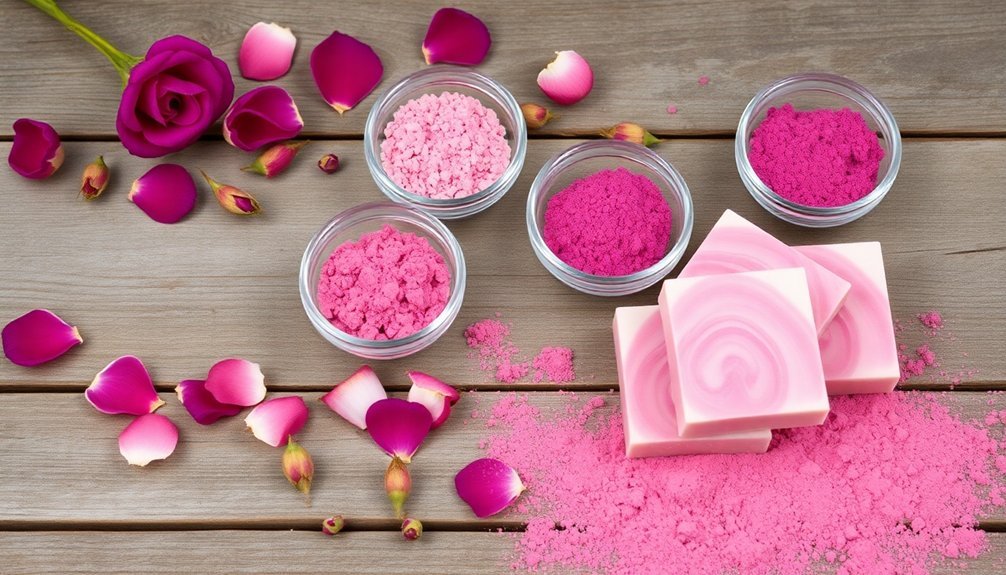
You'll find that wild rose pigments create enchanting pink hues when you gently extract color from both petals and leaves through careful processing.
By adjusting the concentration of rose materials in your soap formula, you can achieve a spectrum of pink shades ranging from subtle blush tones to rich magenta highlights.
Your handcrafted soaps will showcase nature's own color palette while benefiting from the rose pigments' antioxidant properties and skin-nourishing vitamins.
Natural Rose Color Extraction
Three distinct parts of wild roses – petals, leaves, and stems – yield beautiful pink and red pigments perfect for natural soap making.
You'll find that wild rose pigments offer both visual appeal and antioxidant properties when incorporated into your handcrafted soaps. Through natural color extraction methods like cold oil infusions or water steeping, you can achieve varying shades depending on your desired intensity.
- Picture delicate rose petals releasing their rich pigments into clear oil, gradually transforming it into a vibrant pink infusion.
- Envision fresh leaves and stems steeping in water, creating a lighter, more subtle hue.
- Imagine your eco-friendly soaps showcasing nature's own color palette.
Your biodegradable wild rose pigments will respond uniquely to your soap's pH levels, creating one-of-a-kind shades in each batch while maintaining environmental consciousness through sustainable practices.
Petals for Pink Tones
Wild rose petals offer a stunning spectrum of pink possibilities for your natural soap making journey. When you incorporate wild rose pigments into your handcrafted soaps, you'll create beautiful pink tones that elevate your products' visual appeal while adding skin-nourishing properties.
You'll find that the intensity of these natural colorants varies depending on the rose variety and extraction method you choose. By experimenting with different combinations, you can achieve striking contrasts in your soap designs.
What's more, wild rose pigments work harmoniously with other natural colorants, allowing you to create depth and dimension in your soap's appearance.
As a biodegradable ingredient sourced from renewable plants, wild rose pigments align perfectly with eco-conscious soap making practices, making them an excellent choice for your sustainable crafting endeavors.
Shade Variations With Roses
While exploring the diverse world of natural soap making, you'll discover that different wild rose varieties produce distinct pink shades in your finished products.
Wild rose pigments offer you a natural pink hue that transforms your handcrafted soaps into stunning artisan products. You'll find these eco-friendly practices not only create beautiful colors but also provide skin benefits through antioxidants and soothing properties.
- Light extraction methods yield delicate blush tones, perfect for subtle, sophisticated designs
- Medium concentration creates warm, rosy pink shades that capture the essence of blooming gardens
- Intense processing produces deep fuchsia hues, ideal for bold, eye-catching soap bars
When you're working with wild rose pigments, you'll appreciate how each shade variation carries its own unique character while maintaining the gentle, natural fragrance that makes these soaps special.
Blue Cornflower's Natural Indigo Tones
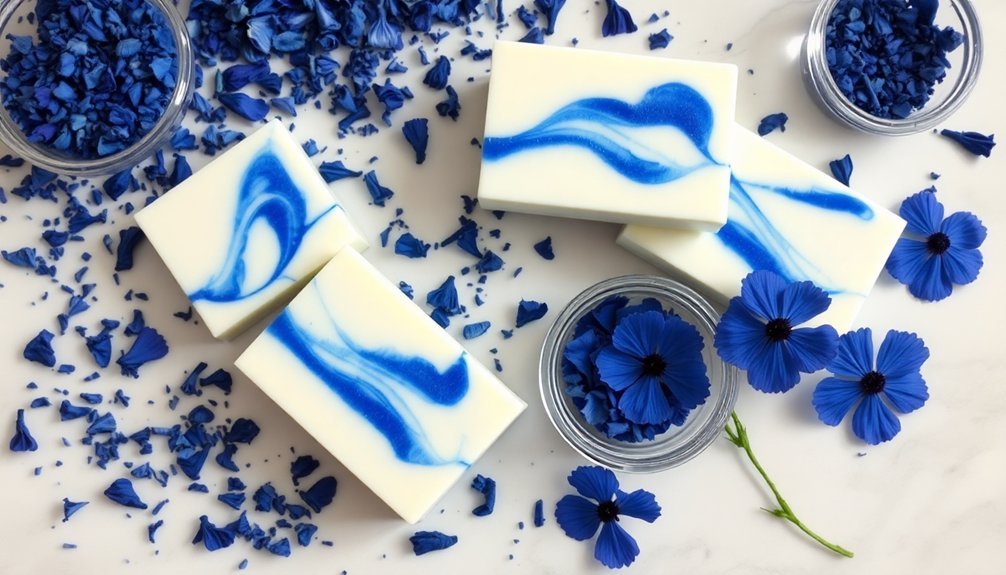
Despite synthetic dyes dominating the market, blue cornflower stands out as nature's answer to achieving stunning indigo tones in handcrafted soaps.
You'll find that this remarkable flower's anthocyanins create beautiful shades ranging from blue to purple, making it a versatile choice for your soap-making projects.
What makes blue cornflower particularly valuable is its ability to maintain its color throughout the saponification process, ensuring your handcrafted soaps retain their visual appeal.
Beyond aesthetics, you're also adding beneficial antioxidant properties to your soap formulations when you incorporate these petals.
By choosing blue cornflower for your natural indigo tones, you're embracing eco-friendly practices while avoiding harmful chemical colorants.
It's a renewable resource that delivers both beauty and functionality to your soap creations.
Safflower's Spectrum From Yellow to Red
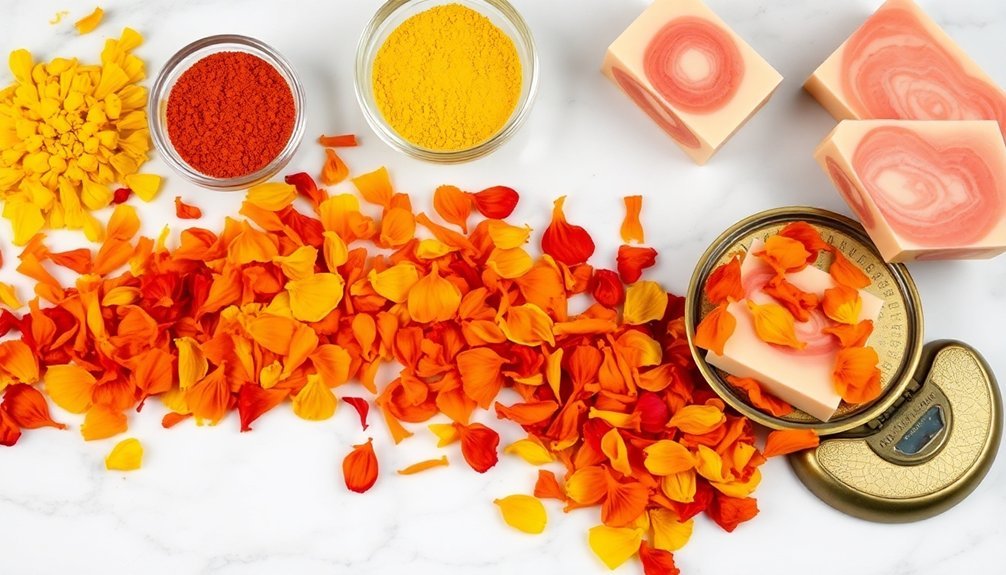
Safflower stands as one of nature's most versatile dye sources, offering soap makers a stunning spectrum from sunny yellows to deep crimsons. You'll find its carotenoid-rich pigments create vivid colors in your handmade soaps while providing skin-nourishing benefits.
When you're working with safflower, you can extract different colors depending on your method, with water-soluble carthamin giving you those striking red tones.
- Picture delicate yellow swirls dancing through your soap bars like rays of sunshine
- Imagine rich amber waves reminiscent of desert sunsets
- Envision deep crimson streaks that transform your soaps into works of art
For natural soap crafting, you'll appreciate that safflower's non-toxic properties make it a safe choice.
The pigments blend beautifully while adding emollient qualities, making your soaps both visually appealing and beneficial for the skin.
Hibiscus Blooms for Deep Ruby Shades
To extract hibiscus pigments for your handcrafted soaps, you'll need to carefully dry the blooms at temperatures between 95-115°F before grinding them into a fine powder.
You can maximize color intensity by infusing the powder in your soap-making oils for 24-48 hours or blending it directly with natural clays.
Store your dried hibiscus powder in an airtight, dark container away from direct sunlight and moisture to maintain its rich ruby hues for up to 12 months.
Natural Color Extraction Methods
When seeking vibrant ruby hues for natural soap making, hibiscus blooms offer one of the most reliable and stunning color options available. Through natural color extraction, you'll create a concentrated infusion by steeping dried flowers in hot water.
Remember to strain the liquid thoroughly to guarantee your final product remains smooth and free of particles.
The hibiscus pigments respond differently based on your soap's pH levels:
- In alkaline conditions, you'll achieve deeper purple undertones
- More acidic environments bring out vibrant red shades
- Neutral pH produces classic ruby tones
As a dual-purpose ingredient, hibiscus doesn't just color your soap—it also delivers skin-benefiting properties.
The flowers' natural antioxidants and exfoliating qualities make them an excellent addition to your soap making arsenal, enhancing both aesthetics and functionality.
Optimal Drying Temperature Range
Since achieving deep ruby shades depends heavily on proper drying techniques, maintaining temperatures between 95°F to 115°F (35°C to 46°C) proves critical for preserving hibiscus blooms' vibrant pigments.
You'll want to dry your hibiscus blooms in a well-ventilated space or use a dehydrator set within this ideal drying temperature range.
It's crucial to keep humidity levels low during the process to prevent mold and protect the flowers' natural anthocyanins – the compounds responsible for those stunning red and purple hues in your handcrafted soaps.
Once you've properly dried your blooms, you can extract maximum color by carefully infusing them in oils or incorporating them into lye solutions at lower temperatures.
This careful temperature control helps prevent the degradation of these precious natural pigments.
Storage For Color Longevity
Proper storage methods dramatically influence the longevity of hibiscus blooms' rich ruby pigments.
You'll want to store pigments in a cool, dry area away from direct sunlight to maintain their vibrant qualities. Using air-tight containers prevents moisture from degrading your natural pigments, guaranteeing they'll retain their potency when you're ready to create your soaps.
- Picture rows of glass jars filled with deep crimson hibiscus petals, neatly labeled and sealed
- Imagine a dedicated storage cabinet with adjustable shelves, protected from light and heat
- Envision perfectly preserved color swatches showing the evolution of your soap's ruby hues
To maximize color longevity, grind your hibiscus blooms finely and add a touch of vitamin E oil to your formulation.
This combination helps guarantee your soaps maintain their stunning ruby shade throughout their shelf life.
Chamomile's Subtle Yellow Undertones
As nature's gentle colorant, chamomile brings subtle yellow undertones to handcrafted soaps through its rich content of flavonoids and carotenoids. You'll find that this natural colorant not only creates a warm, inviting appearance but also offers soothing properties for sensitive skin.
| Infusion Method | Expected Color Result |
|---|---|
| Hot Oil | Deep Yellow |
| Cold Oil | Light Yellow |
| Water-Based | Pale Yellow |
| Direct Powder | Golden Yellow |
| Tea Method | Soft Yellow |
When you're crafting your soaps, you can control the intensity of chamomile's earthy tones by adjusting the amount used during the infusion process. It's versatile enough to blend with other natural colorants, allowing you to create unique color combinations that'll make your handcrafted soaps stand out while maintaining their gentle, natural appeal.
Frequently Asked Questions
What Are the Best Natural Pigments for Soap?
You'll get vibrant colors using clays like bentonite and kaolin, spirulina for green, turmeric for yellow, and beetroot for pink. Annatto seeds and mineral-based earth pigments are also excellent natural soap colorants.
How to Add Pigment to Soap?
Mix your pigment with a small amount of oil to create a slurry first. Then blend it into your cooled soap mixture using an immersion blender, starting with less and adding more until you're satisfied.
How Do You Use Handcrafted Soap?
Lather the handcrafted soap in your hands or on a washcloth, then apply it to your skin. Rinse thoroughly with water. Store your soap in a cool, dry place to maintain its quality.
What Is Handcrafted Soap?
Handcrafted soap is a natural cleanser you'll find made with organic oils and fats through traditional saponification. It's created in small batches by artisans, retaining beneficial glycerin and avoiding synthetic additives.
In Summary
You'll find these seven wildflower pigments offer endless possibilities for creating naturally colorful handcrafted soaps. Whether you're aiming for soft pastels or bold jewel tones, nature's palette provides exactly what you need. Start experimenting with single flowers first, then try combining different pigments to develop your signature colors. Keep notes on your results, and you'll soon master the art of botanical soap coloring.

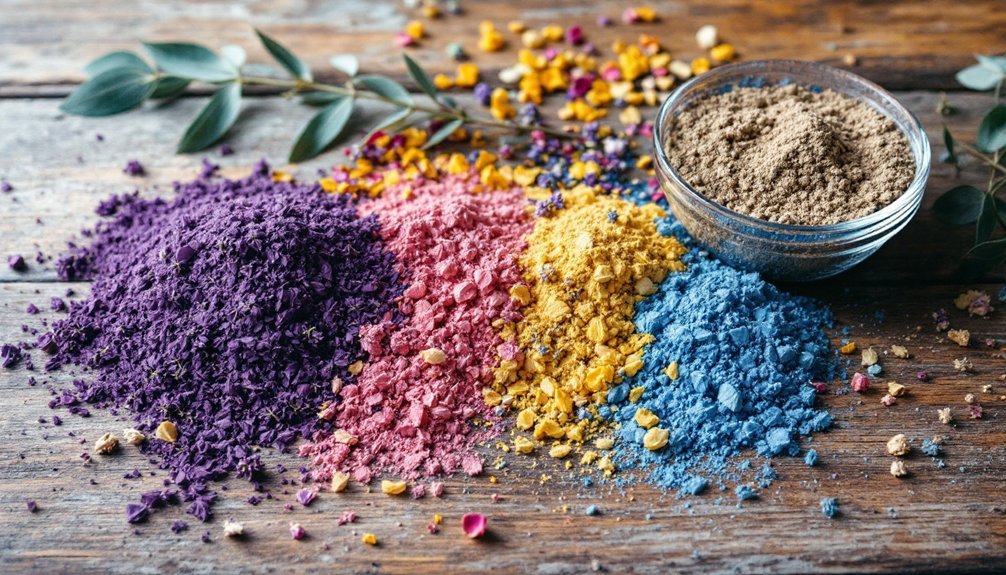



Leave a Reply